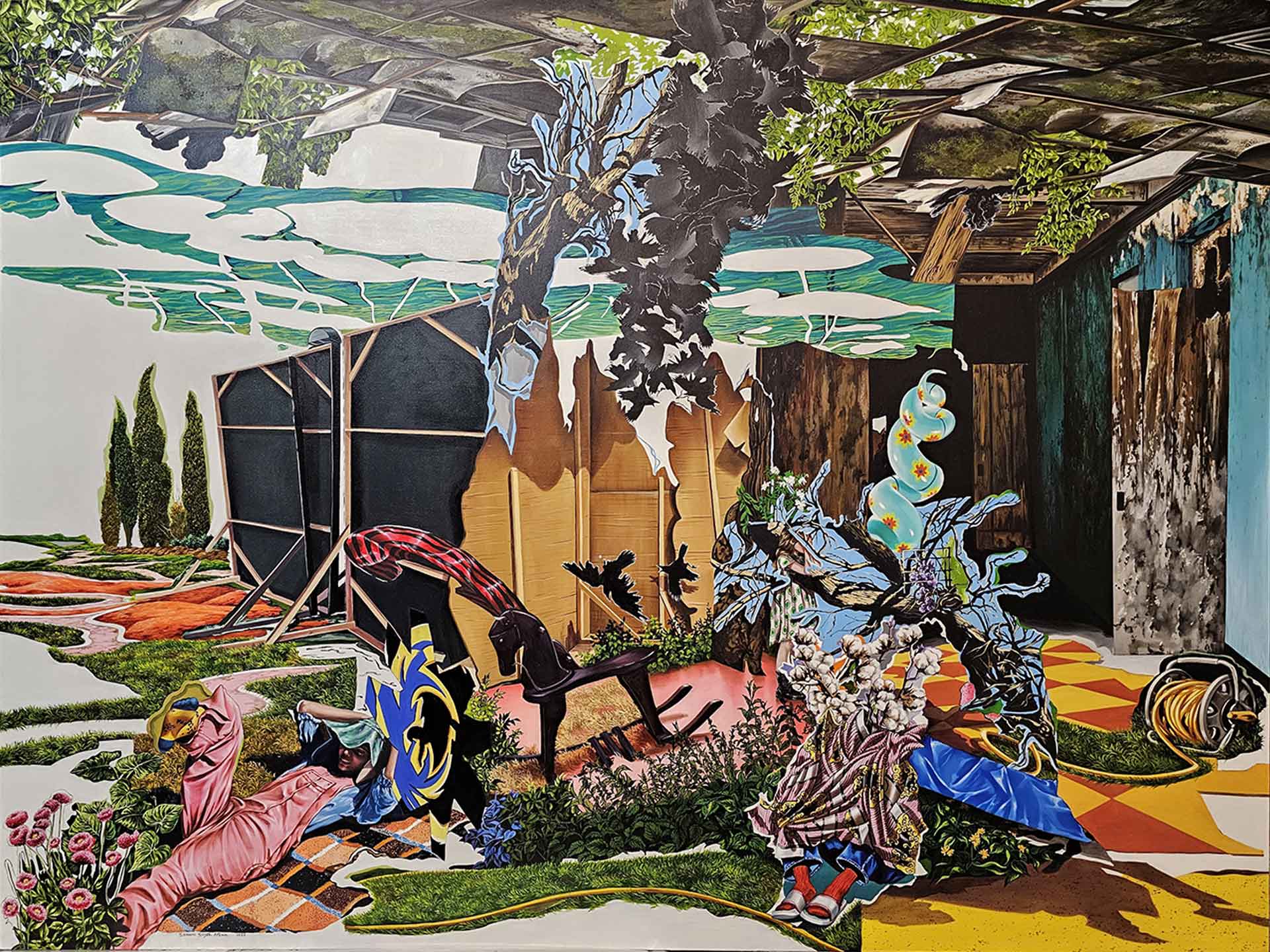
Bavan Gallery is pleased to announce its participation at Contemporary Istanbul 2023 presenting works by Samaneh Abri, Mehrdad Afsari, Maryam Amirvaghefi, Kamran Diba, Leila Ghandchi, Zahra Ghyasi, Ahoo Hamedi, Mehrdad Jafari, Shabnam Jahanshahi, Laleh Memarardestani, Adena Mirzakhanian, Pooneh Oshidari, Mahshid Roshan Tabar, Payam Qelichy, Sanam Sayehafkan, and Mahsa Tehrani.
Individual works
* Press
At the 18th edition of Contemporary Istanbul Art Fair,Tehran-based Bavan Gallery presents a selection of works by 18 Iranian artists. The works on view explore the human body through a multitude of perspectives, metaphors and symbolic representations. Using a diverse set of expressions, approaches and techniques, the artists have sought to amplify the presence of the human body within different contexts.
The booth features a piece by Kamran Diba, one of the pioneering figures in Iranian architecture and visual arts, from his celebrated “Global News Narratives” series. In “On-The-Line”, the artist shrewdly intertwines lines that appear like text columns with the lines in a tennis match, as well as the seemingly-irrelevant lines of news.
In Mehrdad Afsari’s photography from his “Past Continuous” series, the body takes multiple shapes and morphs into a plethora of organic forms. In the work presented at the booth, a rose bud is both personified and becomes a relic from a past time and place, flowing into the present.
Samaneh Abri’s paintings portray a mythological time and space. Often depicting natural environments, her compositions combine landscapes with fiction and fantasy. Her ethereal imagery hints at a pre-human time and a less-devastated earth.
Maryam Amirvaghefi’s diverse artistic practice combines a wide variety of materials, expressions, styles and techniques to create paintings and collages as chronicles of her reactions, recalls, thoughts and their evolution. Both through her creative processes and final compositions, she studies and explores such subjects as gender, how it is perceived, and how it affects socio-political issues.
Leila Ghandchi’s paintings often present the viewer with a fragile situation amidst evolution and breaking. By using a plethora of materials and techniques, she stands within a blurry line between familiarization and defamiliarization. Her compositions study such moments to express how we perceive crises, life and death, loss and hope.
In Zahra Ghyasi’s paintings, the world is depicted as a fragmented yet stretched-out image. The transformations and illusions she creates are rooted in her studies of human pleasure, sexuality identity, and perception of self within history.
Ahoo Hamedi takes a spontaneous approach to painting, reacting to her inner and outer inputs through fragile yet determined watercolor and ink paintings. Her work is often autobiographical and directly inspired by her personal experiences.
Mehrdad Jafari’s diary-like collages and paintings create pieces that chronicle his life, experiences and encounters. Over the years, his work has evolved into a unique style and expression, taking in whatever he appropriates as part of his practice, themes and subject matter.
Shabnam Jahanshahi’s work combines drawing, Persian Miniature, medieval European imagery, modern photography, contemporary media representation and classical portraiture. Her pieces can be seen as multi-faceted commentaries on issues related to gender and identity within her society.
The booth features a piece by Kamran Diba, one of the pioneering figures in Iranian architecture and visual arts, from his celebrated “Global News Narratives” series. In “On-The-Line”, the artist shrewdly intertwines lines that appear like text columns with the lines in a tennis match, as well as the seemingly-irrelevant lines of news.
In Mehrdad Afsari’s photography from his “Past Continuous” series, the body takes multiple shapes and morphs into a plethora of organic forms. In the work presented at the booth, a rose bud is both personified and becomes a relic from a past time and place, flowing into the present.
Samaneh Abri’s paintings portray a mythological time and space. Often depicting natural environments, her compositions combine landscapes with fiction and fantasy. Her ethereal imagery hints at a pre-human time and a less-devastated earth.
Maryam Amirvaghefi’s diverse artistic practice combines a wide variety of materials, expressions, styles and techniques to create paintings and collages as chronicles of her reactions, recalls, thoughts and their evolution. Both through her creative processes and final compositions, she studies and explores such subjects as gender, how it is perceived, and how it affects socio-political issues.
Leila Ghandchi’s paintings often present the viewer with a fragile situation amidst evolution and breaking. By using a plethora of materials and techniques, she stands within a blurry line between familiarization and defamiliarization. Her compositions study such moments to express how we perceive crises, life and death, loss and hope.
In Zahra Ghyasi’s paintings, the world is depicted as a fragmented yet stretched-out image. The transformations and illusions she creates are rooted in her studies of human pleasure, sexuality identity, and perception of self within history.
Ahoo Hamedi takes a spontaneous approach to painting, reacting to her inner and outer inputs through fragile yet determined watercolor and ink paintings. Her work is often autobiographical and directly inspired by her personal experiences.
Mehrdad Jafari’s diary-like collages and paintings create pieces that chronicle his life, experiences and encounters. Over the years, his work has evolved into a unique style and expression, taking in whatever he appropriates as part of his practice, themes and subject matter.
Shabnam Jahanshahi’s work combines drawing, Persian Miniature, medieval European imagery, modern photography, contemporary media representation and classical portraiture. Her pieces can be seen as multi-faceted commentaries on issues related to gender and identity within her society.
Laleh Memarardestani has been focused on drawing and printmaking for many years, creating pieces that appear like organic forms and depictions that are inspired by plant life as well as every experience. Taking a meditative approach, she seeks to use minimalistic expressions to emphasize a deep contemplative effect.
Adena Mirzakhanian’s paintings induce motion, stillness and suspense to portray a rendition of time, sequence and memory. By using repetition and creating patterns that vary only slightly, her work generates rhythm and depth, taking the viewer to look at her subject through different angles.
In the work of Roghayeh Najdi, the human body is often depicted like photo negatives within a void, taking away some of its spatiotemporal qualities, identity and sense of belonging, filling up the context with her signature flowers that breathe life and hope.
Pooneh Oshidari creates landscapes that resemble to her an image of ‘home’ as a safe yet ephemeral place or concept. By using a diversity of techniques with a special focus on mono printing, she distances herself from the final image, as if hinting at the unattainability of her landscapes.
In her three-dimensional work, Mahshid Roshan Tabar has sought to focus on the very essence of her materials, creating a spiritual connection to the base soil and clay as well as simple forms that come together as complicated webs as they multiply.
The intricate drawings of Payam Qelichy explore human pain and suffering within a chaotic realm. In his detailed works, he aims to expose paradoxes and under-layers of hopelessness in human understanding and perception, and contrast these with how we are under the illusion to create an ideal world.
The paintings of Sanam Sayehafkan depict dream states, illusions and visions. They appear to give hints about an event, a narrative or a plot, yet fluidly escape the grasp of the onlooker. By using contrasty, sharp hues and acute lines in her compositions, her imagery seems to defy the boundaries of natural forces and border into fantasy and imagination.
Mahsa Tehrani’s panoramic paintings simultaneously present a grand narrative and delve into its deeper micro-narratives. By laying expansive grounds, her compositions host multiple scenarios, situations, times and sequences, bordering along remembrance and forgetfulness, knowledge and loss, life and death, presence and absence, desire and aversion.
By exploring the relationships of objects within the kitchen, their configurations, uses and contextualizing within a painterly world, Minoo Yalsohrabi obsessively yet playfully studies motion, cause and effect, bodies, human intervention, historically-assigned gender roles and identities, as well as light and shadow.
Adena Mirzakhanian’s paintings induce motion, stillness and suspense to portray a rendition of time, sequence and memory. By using repetition and creating patterns that vary only slightly, her work generates rhythm and depth, taking the viewer to look at her subject through different angles.
In the work of Roghayeh Najdi, the human body is often depicted like photo negatives within a void, taking away some of its spatiotemporal qualities, identity and sense of belonging, filling up the context with her signature flowers that breathe life and hope.
Pooneh Oshidari creates landscapes that resemble to her an image of ‘home’ as a safe yet ephemeral place or concept. By using a diversity of techniques with a special focus on mono printing, she distances herself from the final image, as if hinting at the unattainability of her landscapes.
In her three-dimensional work, Mahshid Roshan Tabar has sought to focus on the very essence of her materials, creating a spiritual connection to the base soil and clay as well as simple forms that come together as complicated webs as they multiply.
The intricate drawings of Payam Qelichy explore human pain and suffering within a chaotic realm. In his detailed works, he aims to expose paradoxes and under-layers of hopelessness in human understanding and perception, and contrast these with how we are under the illusion to create an ideal world.
The paintings of Sanam Sayehafkan depict dream states, illusions and visions. They appear to give hints about an event, a narrative or a plot, yet fluidly escape the grasp of the onlooker. By using contrasty, sharp hues and acute lines in her compositions, her imagery seems to defy the boundaries of natural forces and border into fantasy and imagination.
Mahsa Tehrani’s panoramic paintings simultaneously present a grand narrative and delve into its deeper micro-narratives. By laying expansive grounds, her compositions host multiple scenarios, situations, times and sequences, bordering along remembrance and forgetfulness, knowledge and loss, life and death, presence and absence, desire and aversion.
By exploring the relationships of objects within the kitchen, their configurations, uses and contextualizing within a painterly world, Minoo Yalsohrabi obsessively yet playfully studies motion, cause and effect, bodies, human intervention, historically-assigned gender roles and identities, as well as light and shadow.
* Catalogue





